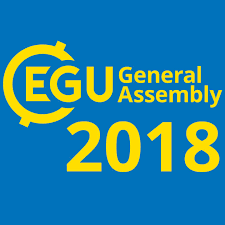 The EGU General Assembly brings together geoscientists from all over the world. This year it took place in Vienna, Austria, from April 8 to 13, 2018. Kateřina Jandová, a junior researcher of Center for Geosphere Dynamics was not only participating in this important meeting with her poster but also co-organizing scientific session GM3.3/BG2.8/CL4.27/SSS3.4 Chemical weathering, soil formation, and organic carbon mobilization across spatial and temporal scales. She presented her results on microbial utilization of geogenic organic matter based on 14C measurement of respired CO2 and microbial biomarkers. These very fresh results obtained during her research stay at the MPI for Biogeochemistry in Jena will hopefully make a nice paper soon.
The EGU General Assembly brings together geoscientists from all over the world. This year it took place in Vienna, Austria, from April 8 to 13, 2018. Kateřina Jandová, a junior researcher of Center for Geosphere Dynamics was not only participating in this important meeting with her poster but also co-organizing scientific session GM3.3/BG2.8/CL4.27/SSS3.4 Chemical weathering, soil formation, and organic carbon mobilization across spatial and temporal scales. She presented her results on microbial utilization of geogenic organic matter based on 14C measurement of respired CO2 and microbial biomarkers. These very fresh results obtained during her research stay at the MPI for Biogeochemistry in Jena will hopefully make a nice paper soon.
Interview with Jakub Trubač, a junior researcher of the Center
 As a part of a special issue of the university journal Forum dedicated to 670th anniversary of Charles University foundation, Jakub Trubač, a junior researcher of Center for Geosphere Dynamics was interviewed as a representative of Faculty of Science. He starts with the citation of one of his teachers, Dr. Fratišek V. Holub, who said: “Rocks are the only solid basis of our world”:-) Enjoy the interview on pages 52-53 of the electronic document (link).
As a part of a special issue of the university journal Forum dedicated to 670th anniversary of Charles University foundation, Jakub Trubač, a junior researcher of Center for Geosphere Dynamics was interviewed as a representative of Faculty of Science. He starts with the citation of one of his teachers, Dr. Fratišek V. Holub, who said: “Rocks are the only solid basis of our world”:-) Enjoy the interview on pages 52-53 of the electronic document (link).
Stress-controlled and discontinuity-related weathering forms called „arcades“ described
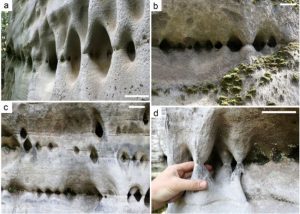 Critical evaluation of hundreds of photos of sandstone and other granular rock outcrops taken in various regions around the world revealed a presence of a specific sub-group of weathering forms related to planar discontinuities, hereby called arcades. The arcades are characterized as pits and cavities varying in size, but similar in shape, coalesced into „trains“ along the discontinuities, and separated from each other by hourglass-shaped pillars. In their origin and geometry, these forms differ from widely known cavernous weathering forms such as honeycombs and tafoni. Using numerical and physical in situ modelling, it has been shown that arcade shape and size are controlled by the redistribution of gravity-induced stress along planar discontinuities and the resulting stress shadow, which is characterized by material loss owing to various weathering and erosional mechanisms.
Critical evaluation of hundreds of photos of sandstone and other granular rock outcrops taken in various regions around the world revealed a presence of a specific sub-group of weathering forms related to planar discontinuities, hereby called arcades. The arcades are characterized as pits and cavities varying in size, but similar in shape, coalesced into „trains“ along the discontinuities, and separated from each other by hourglass-shaped pillars. In their origin and geometry, these forms differ from widely known cavernous weathering forms such as honeycombs and tafoni. Using numerical and physical in situ modelling, it has been shown that arcade shape and size are controlled by the redistribution of gravity-induced stress along planar discontinuities and the resulting stress shadow, which is characterized by material loss owing to various weathering and erosional mechanisms.
Filippi M., Bruthans J., Řihošek J., Slavík M., Adamovič J., Mašín D. (2018): Arcades: Products of stress-controlled and discontinuity-related weathering. Earth-Science Reviews 180, 159–184. (DOI)
Thallium in polluted desert soils
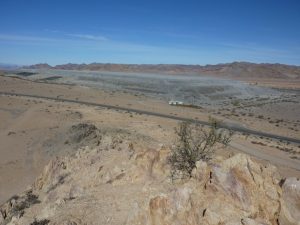 A combination of multiple techniques including XAS and isotopes helped to decipher the mobility of Tl in mining-polluted desert soil in Namibia. Mechanical transport of fine particles of post-flotation tailings is probably responsible for Tl dispersion in soil profiles.
A combination of multiple techniques including XAS and isotopes helped to decipher the mobility of Tl in mining-polluted desert soil in Namibia. Mechanical transport of fine particles of post-flotation tailings is probably responsible for Tl dispersion in soil profiles.
Grösslová Z., Vaněk A., Oborná V., Mihaljevič M., Ettler V., Trubač J., Drahota P., Penížek V., Pavlů L., Sracek O., Kříbek B., Voegelin A., Göttlicher J., Drábek O., Tejnecký V., Houška J., Mapani B., Zádorová T. (2018): Thallium contamination in desert soil in Namibia: Chemical, mineralogical and isotopic insights. Environmental Pollution 239, 272-280. (DOI)
Unique preservation of the fossil Sepia soft tissues
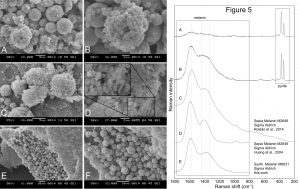 The oldest and until now the only fossil cuttlefish ink sac, possessing microbodies, has been recorded in the Middle Miocene (~13.5-Ma) deposits of the Vienna Basin. The geochemistry of these microbodies has been compared with the ink of the extant genus Sepia. The Raman spectra of melanin from the fossil cuttlefish ink, the S.officinalis melanin, and the synthetic melanin standards, showed identical curves. Therefore, the preservation of delicate cell organelles such as melanosomes has been proven in the fossil material. This investigation also indicates that the melanin (eumelanin) can be resistant to degradation in deep (geological) time.
The oldest and until now the only fossil cuttlefish ink sac, possessing microbodies, has been recorded in the Middle Miocene (~13.5-Ma) deposits of the Vienna Basin. The geochemistry of these microbodies has been compared with the ink of the extant genus Sepia. The Raman spectra of melanin from the fossil cuttlefish ink, the S.officinalis melanin, and the synthetic melanin standards, showed identical curves. Therefore, the preservation of delicate cell organelles such as melanosomes has been proven in the fossil material. This investigation also indicates that the melanin (eumelanin) can be resistant to degradation in deep (geological) time.
Košťák, M., Schlögl, J., Culka, A., Tomašových, A., Mazuch, M., Hudáčková, N. (2018): The unique preservation of Sepia soft tissues in the Miocene deposits (Serravalian, Vienna Basin): Implications for the origin of microbodies in the fossil record. Palaeogeography, Palaeoclimatlogy, Palaeoecology 493, 111-118. (DOI)
Transformation of copper smelter flue dust in contrasting soils
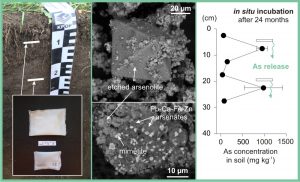 A first long-term (2 years) field experiment indicated how As and other metal(loid) contaminants can be released from As-rich copper smelter flue dust after deposition in contrasting soils. Up to 72% of As was leached out from the flue dust after incubation. The majority of As became highly mobile and could represent a risk for individual environmental compartments (soil, water).
A first long-term (2 years) field experiment indicated how As and other metal(loid) contaminants can be released from As-rich copper smelter flue dust after deposition in contrasting soils. Up to 72% of As was leached out from the flue dust after incubation. The majority of As became highly mobile and could represent a risk for individual environmental compartments (soil, water).
Jarošíková A., Ettler V., Mihaljevič M., Penížek V., Matoušek T., Culka A., Drahota P. (2018): Transformation of arsenic-rich copper smelter flue dust in contrasting soils: A 2-year field experiment. Environmental Pollution 237, 83-92. (DOI)
Alice Jarošíková defended her PhD
 On Friday February 3, 2018, Alice Jarošíková defended her PhD entitled “Experimental in situ transformation of smelting wastes in soils”. On the photo, where she is second from the left, you find her together with two reviewers Prof. Edgar Hiller and Prof. Barbora Doušová and her supervisor, Prof. Vojtěch Ettler. Alice thus became a brand new junior team member of the Center. Congratulations!
On Friday February 3, 2018, Alice Jarošíková defended her PhD entitled “Experimental in situ transformation of smelting wastes in soils”. On the photo, where she is second from the left, you find her together with two reviewers Prof. Edgar Hiller and Prof. Barbora Doušová and her supervisor, Prof. Vojtěch Ettler. Alice thus became a brand new junior team member of the Center. Congratulations!
Successful kick-off meeting on 25/1/2018
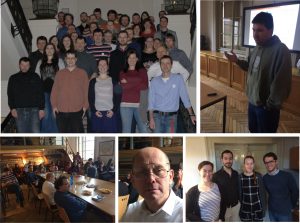 All the team of the Center for Geosphere Dynamics met on January 25, 2018 to launch the activities of the project!
All the team of the Center for Geosphere Dynamics met on January 25, 2018 to launch the activities of the project!
Mapping of radiation anomalies using UAV mini-airborne gamma-ray spectrometry
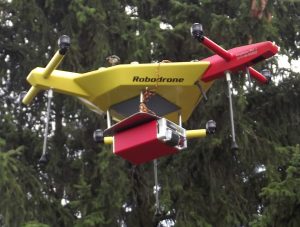
A novel gamma-ray UAV high sensitive system was tested on real uranium anomaly by Ondřej Šálek and his collaborators. The uranium anomaly was indicated at flight altitudes up to 40 m. Recorded data quality is comparable with classic airborne measurement and the introduced device is easily applicable in radiometric survey of a limited area.
Šálek O., Matolín M., Gryc L. (2018): Mapping of radiation anomalies using UAV mini-airborne gamma-ray spectrometry. Journal of Environmental Radioactivity 182, 101-107. (DOI)
First paper dedicated to the Center!
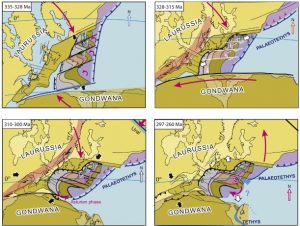
A new review paper co-authored by Ondrej Lexa deals with a synthesis of paleomagnetic data in the Variscan belt. Significant conclusions about the movements and rotations of the most important continental blocks involved in the Pangea assembly are extracted. These data are correlated with palaeomagnetic records from Gondwana and Baltica in order to provide a large-scale geodynamic framework of the European Variscides during the Carboniferous to Permian times.
Edel J.B., Schulmann K., Lexa O., Lardeaux J.M. (2018): Late Palaeozoic palaeomagnetic and tectonic constraints for amalgamation of Pangea supercontinent in the European Variscan belt. Earth-Science Reviews 177, 589-612. (DOI)








